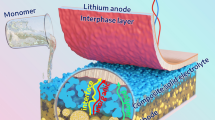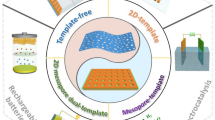Abstract
A novel three-dimensional (3D) carbon nanotube foams (CNTF) with ultrahigh specific surface area have been fabricated through a unique but facile one-step synthesis by using CO2 as both carbon source and activating agent. The activation temperature and time have been adjusted, and the best sample demonstrates a specific surface area of 1959.8 m2 g–1 and a total pore volume of 3.23 cm3 g–1. A reversible capacity of about 870 mAh g–1 is maintained at 50 mA g–1 when the CNTF used as cathode materials. Meanwhile, the capacity is as large as 320 mAh g–1 at the current density of 2 A g–1and the capacity retention is nearly 100% after 500 cycles. These excellent and highly stable battery performances should be attributed to the structural advantages of as-synthesized CNTFs generated by using a facile CO2-assisted strategy, which may potentially be applied in large scale production of porous 3D carbon materials in the fields of energy storage and conversion.
Similar content being viewed by others
References
Zhou L M, Zhang K, Hu Z, et al. Recent developments on and prospects for electrode materials with hierarchical structures for lithiumion batteries. Adv Energy Mater, 2018, 8: 1701415
Zhang L L, Zhao X S. Carbon-based materials as supercapacitor electrodes. Chem Soc Rev, 2009, 38: 2520–2531
Yoo E J, Kim J, Hosono E, et al. Large reversible Li storage of graphene nanosheet families for use in rechargeable lithium ion batteries. Nano Lett, 2008, 8: 2277–2282
Huang X, Wang R, Xu D, et al. Homogeneous CoO on graphene for Binder-free and ultralong-life lithium ion batteries. Adv Funct Mater, 2013, 23: 4345–4353
Hu Y S, Adelhelm P, Smarsly B, et al. Synthesis of hierarchically porous carbon monoliths with highly ordered microstructure and their application in rechargeable lithium batteries with high-rate capability. Adv Funct Mater, 2007, 17: 1873–1878
Wang H G, Yuan S, Ma D L, et al. Tailored aromatic carbonyl derivative polyimides for high-power and long-cycle sodium-organic batteries. Adv Energy Mater, 2014, 4, 1301651
Kaskhedikar N A, Maier J. Lithium storage in carbon nanostructures. Adv Mater, 2009, 21: 2664–2680
Li C, Zhang X, Wang K, et al. Scalable self-propagating high-temperature synthesis of graphene for supercapacitors with superior power density and cyclic stability. Adv Mater, 2017, 29: 1604690
Zeng S Z, Zeng X, Tu W, et al. Facile and tailored synthesis of ultrahigh-surface-area clews of carbon nanobelts for high-rate lithium–sulfur batteries. J Mater Chem A, 2017, 5: 23209–23220
Wang Z L, Xu D, Wang H G, et al. In situ fabrication of porous graphene electrodes for high-performance energy storage. ACS Nano, 2013, 7, 2422
Shi S Q, Jian G, Yue L, et al. Multi-scale computation methods: Their applications in lithium-ion battery research and development. Chin Phys B, 2016, 25: 018212
Chen Y, Li X, Park K, et al. Hollow carbon-nanotube/carbon-nanofiber hybrid anodes for Li-ion batteries. J Am Chem Soc, 2013, 135: 16280–16283
Zhang X, Zhang H, Li C, et al. Recent advances in porous graphene materials for supercapacitor applications. RSC Adv, 2014, 4: 45862–45884
Wang B, Qiu J, Feng H, et al. KOH-activated nitrogen doped porous carbon nanowires with superior performance in supercapacitors. Electrochim Acta, 2016, 190: 229–239
Zhou L, Zhuang Z, Zhao H, et al. Intricate hollow structures: Controlled synthesis and applications in energy storage and conversion. Adv Mater, 2017, 29: 1602914
Wang H, Wu Z, Meng F, et al. Nitrogen-doped porous carbon nanosheets as low-cost, high-performance anode material for sodium-ion batteries. ChemSusChem, 2013, 6: 56–60
Chmiola J, Yushin G, Gogotsi Y, et al. Anomalous increase in carbon capacitance at pore sizes less than 1 nanometer. Science, 2006, 313: 1760–1763
Raymundo-Piñero E, Azaïs P, Cacciaguerra T, et al. KOH and NaOH activation mechanisms of multiwalled carbon nanotubes with different structural organisation. Carbon, 2005, 43: 786–795
Liu S, Peng W, Sun H, et al. Physical and chemical activation of reduced graphene oxide for enhanced adsorption and catalytic oxidation. Nanoscale, 2014, 6: 766–771
Sevilla M, Mokaya R. Energy storage applications of activated carbons: supercapacitors and hydrogen storage. Energy Environ Sci, 2014, 7: 1250–1280
Jia J, Wang K, Zhang X, et al. Graphene-based hierarchically micro/mesoporous nanocomposites as sulfur immobilizers for high-performance lithium–sulfur batteries. Chem Mater, 2016, 28: 7864–7871
Bedin K C, Martins A C, Cazetta A L, et al. KOH-activated carbon prepared from sucrose spherical carbon: Adsorption equilibrium, kinetic and thermodynamic studies for Methylene Blue removal. Chem Eng J, 2016, 286: 476–484
Meng J, Liu X, Li J, et al. General oriented synthesis of precise carbon-confined nanostructures by low-pressure vapor superassembly and controlled pyrolysis. Nano Lett, 2017, 17: 7773–7781
Xu J, Tan Z, Zeng W, et al. A hierarchical carbon derived from sponge-templated activation of graphene oxide for high-performance supercapacitor electrodes. Adv Mater, 2016, 28: 5222–5228
Li Y, Wang G, Wei T, et al. Nitrogen and sulfur co-doped porous carbon nanosheets derived from willow catkin for supercapacitors. Nano Energy, 2016, 19: 165–175
Wang C, Feng Y, Sun X, et al. Fabrication and activation of carbon nanotube foam and its application in energy storage. Electrochim Acta, 2017, 236: 343–350
Wang J, Kaskel S. KOH activation of carbon-based materials for energy storage. J Mater Chem, 2012, 22: 23710
Zhang L, Zhang F, Yang X, et al. Porous 3D graphene-based bulk materials with exceptional high surface area and excellent conductivity for supercapacitors. Sci Rep, 2013, 3: 1408
Yuan S, Huang X, Ma D, et al. Engraving copper foil to give largescale binder-free porous CuO arrays for a high-performance sodiumion battery anode. Adv Mater, 2014, 26: 2273–2279
Huang X, Xu D, Yuan S, et al. Dendritic Ni-P-coated melamine foam for a lightweight, low-cost, and amphipathic three-dimensional current collector for binder-free electrodes. Adv Mater, 2014, 26: 7264–7270
Hou J, Cao C, Idrees F, et al. Hierarchical porous nitrogen-doped carbon nanosheets derived from silk for ultrahigh-capacity battery anodes and supercapacitors. ACS Nano, 2015, 9: 2556–2564
Ferrari A C, Rodil S E, Robertson J. Interpretation of infrared and Raman spectra of amorphous carbon nitrides. Phys Rev B, 2003, 67: 155306
Tuinstra F, Koenig J L. Raman spectrum of graphite. J Chem Phys, 1970, 53: 1126–1130
Delhaes P. Chemical vapor deposition and infiltration processes of carbon materials. Carbon, 2002, 40: 641–657
M Kumar. Carbon nanotube synthesis and growth mechanism. In: Carbon Nanotubes–Synthesis Characterization, Applications. First ed., Intech Rijeka, 2011
Zhukovskii Y F, Kotomin E A, Balaya P, et al. Enhanced interfacial lithium storage in nanocomposites of transition metals with LiF and Li2O: Comparison of DFT calculations and experimental studies. Solid State Sci, 2008, 10: 491–495
Zhou H, Zhu S, Hibino M, et al. Lithium storage in ordered mesoporous carbon (CMK-3) with high reversible specific energy capacity and good cycling performance. Adv Mater, 2003, 15: 2107–2111
Zou G, Hou H, Cao X, et al. 3D hollow porous carbon microspheres derived from Mn-MOFs and their electrochemical behavior for sodium storage. J Mater Chem A, 2017, 5: 23550–23558
Qin J, He C, Zhao N, et al. Graphene networks anchored with Sn@Graphene as lithium ion battery anode. ACS Nano, 2017, 8: 1728–1738
Li J, Hou Y, Gao X, et al. A three-dimensionally interconnected carbon nanotube/layered MoS2 nanohybrid network for lithium ion battery anode with superior rate capacity and long-cycle-life. Nano Energy, 2015, 16: 10–18
Deschamps M, Yazami R. Great reversible capacity of carbon lithium electrode in solid polymer electrolyte. J Power Sources, 1997, 68: 236–238
Wang X, Yang Z, Sun X, et al. NiO nanocone array electrode with high capacity and rate capability for Li-ion batteries. J Mater Chem, 2011, 21: 9988–9990
Ge D, Wu J, Qu G, et al. Rapid and large-scale synthesis of bare Co3O4 porous nanostructures from an oleate precursor as superior Li-ion anodes with long-cycle lives. Dalton Trans, 2016, 45: 13509–13513
Ma D, Cao Z, Wang H, et al. Three-dimensionally ordered macroporous FeF3 and its in situ homogenous polymerization coating for high energy and power density lithium ion batteries. Energy Environ Sci, 2012, 5: 8538–8542
Author information
Authors and Affiliations
Corresponding author
Rights and permissions
About this article
Cite this article
Yu, P., Yuan, Y. One-step synthesis of robust carbon nanotube foams with ultrahigh surface area for high-performance lithium ion battery. Sci. China Technol. Sci. 62, 464–471 (2019). https://doi.org/10.1007/s11431-018-9340-0
Received:
Accepted:
Published:
Issue Date:
DOI: https://doi.org/10.1007/s11431-018-9340-0




